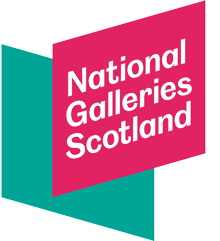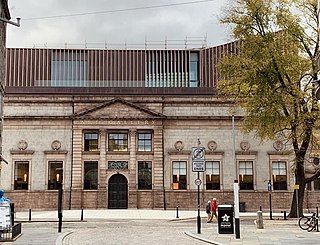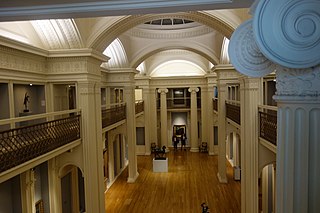
The Scottish National Gallery is the national art gallery of Scotland. It is located on The Mound in central Edinburgh, close to Princes Street. The building was designed in a neoclassical style by William Henry Playfair, and first opened to the public in 1859.

The Scottish Colourists were a group of four painters, three from Edinburgh, whose Post-Impressionist work, though not universally recognized initially, came to have a formative influence on contemporary Scottish art and culture. They were Francis Cadell, John Duncan Fergusson, Leslie Hunter and Samuel Peploe.

National Galleries of Scotland is the executive non-departmental public body that controls the three national galleries of Scotland and two partner galleries, forming one of the National Collections of Scotland.

Modern Two, formerly the Dean Gallery, in Edinburgh, is one of the two buildings housing the Scottish National Gallery of Modern Art, one of Scotland's national art galleries. It is operated by the National Galleries of Scotland.

The Royal Scottish Academy building, the home of the Royal Scottish Academy, is situated on The Mound in the centre of Edinburgh, was built by William Henry Playfair in 1822-6 and extended in 1831-6 for the Board of Manufactures and Fisheries. Along with the adjacent National Gallery of Scotland, their neo-classical design helped transform Edinburgh into a modern-day Athens of the North.

Kelvingrove Art Gallery and Museum is a museum and art gallery in Glasgow, Scotland. It reopened in 2006 after a three-year refurbishment and since then has been one of Scotland's most popular visitor attractions. The museum has 22 galleries, housing a range of exhibits, including Renaissance art, taxidermy, and artifacts from ancient Egypt.

The Scottish National Portrait Gallery is an art museum on Queen Street, Edinburgh. The gallery holds the national collections of portraits, all of which are of, but not necessarily by, Scots. It also holds the Scottish National Photography Collection.

The Scottish National Gallery of Modern Art is part of the National Galleries of Scotland, which are based in Edinburgh, Scotland. The National Gallery of Modern Art houses the collection of modern and contemporary art dating from about 1900 to the present in two buildings, Modern One and Modern Two, that face each other on Belford Road to the west of the city centre.

The Royal Scottish Academy (RSA) is the country’s national academy of art. It promotes contemporary Scottish art.

The Gallery of Modern Art (GoMA) is the main gallery of contemporary art in Glasgow, Scotland.

The Queen's Gallery is an art gallery in Edinburgh, Scotland. It forms part of the Palace of Holyroodhouse complex. It was opened in 2002 by Queen Elizabeth II, and exhibits works from the Royal Collection. It is open to the public daily.

Aberdeen Art Gallery is the main visual arts exhibition space in the city of Aberdeen, Scotland. It was founded in 1884, in a building designed by Alexander Marshall Mackenzie, with a sculpture court added in 1905. In 1900 it received the art collection of Alexander Macdonald, a local granite merchant. The gallery is noted for its fine collection of modern Scottish and international art, including works by Ken Currie, Gilbert & George, Ivor Abrahams, Bridget Riley and Bruce McLean.

The Fruitmarket Gallery is a contemporary art gallery in Edinburgh, Scotland.

Talbot Rice Gallery is the public art gallery of the University of Edinburgh, in Scotland. With a 19th-century former natural history museum and a contemporary white cube gallery.

The National Museum of Scotland in Edinburgh, Scotland, was formed in 2006 with the merger of the new Museum of Scotland, with collections relating to Scottish antiquities, culture and history, and the adjacent Royal Scottish Museum, with international collections covering science and technology, natural history, and world cultures. The two connected buildings stand beside each other on Chambers Street, by the intersection with the George IV Bridge, in central Edinburgh. The museum is part of National Museums Scotland. Admission is free.

The Palace of Holyroodhouse, commonly referred to as Holyrood Palace or Holyroodhouse, or Holyrood Castle, is the official residence of the British monarch in Scotland. Located at the bottom of the Royal Mile in Edinburgh, at the opposite end to Edinburgh Castle, Holyroodhouse has served as the principal royal residence in Scotland since the 16th century, and is a setting for state occasions and official entertaining.
Events from the year 1889 in Scotland.
Events from the year 1594 in the Kingdom of Scotland.

The Great Tapestry of Scotland is one of the world's largest community arts projects, hand stitched by 1,000 people from across Scotland. It is made up of 160 linen panels and 300 miles of wool – enough to stretch the entire length of Scotland. It is now on permanent display in its own purpose-built gallery and visitor centre in the town of Galashiels in the heartland of the Scottish Borders.